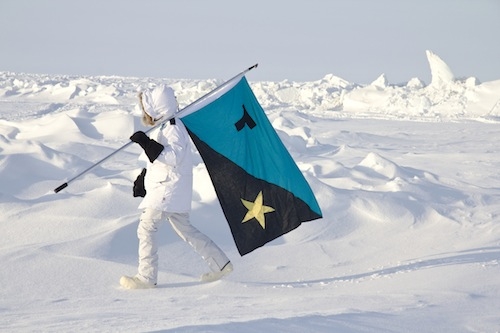ArtReview sent a questionnaire to a selection of the artists exhibiting in various national pavilions of the Venice Biennale, the responses to which will be published over the coming days. Tavares Strachan is representing The Bahamas. The pavilion is in the Arsenale.
What can you tell us about your plans for Venice?
The Venice project has been in the works for over three years. Now, in the thick of production, it’s clear that a number of individual works will create one, singular experience. I’m answering this question from a small cabin in Svalbard, just one day back from a journey to the North Pole. The trip is part of my subject matter for the exhibition. I’m very interested in concepts of distance, displacement, and invisibility – I’ll be using these ideas to break down conventional archetypes.
Are you approaching the show in a different way to how you would with a ‘normal’ exhibition?
There’s not much that is normal about either Venice or the Biennale. For starters, it’s a city on the water. It floods regularly and seems precarious, but was the seat of a long republic. On top of that, the Biennale itself is based on a nineteenth century idea of nationalism. It’s a conflicted space. But in general, I am racking my brain even trying to think of what a ‘normal’ exhibition might be?
What does it mean to ‘represent’ your country? Do you find it an honor or problematic?
I always get in trouble with my friends when I answer something this way. Of course, it’s both an honor and extremely problematic. Can someone really represent a country? George W Bush had an eight year run in the US, President Obama is on his second term, and they both have, on some level, represented their country (or different countries within their country). I would argue that most artists presenting work in national pavilions are, first and formost, representing themselves.
In the context of Venice, The Bahamas is far less established – it’s the first representation. The country is now 40 years old, and that comes with some pressure and responsibility. Most artists might argue that the process of artistic practice now is more about being a citizen of the world than representing one particular place. It’s more complicated that that—but I agree.
What audience are you addressing with the work? The masses of artist peers, gallerists, curators and critics concentrated around the opening or the general public who come through over the following months?
All of the above.
What are your earliest or best memories of the biennale?
I’ve heard many stories from friends about presenting work at the Biennale, but I’ve never been in Venice during the event. A good friend of mine, the artist Michael Joo, cut up a huge tree and installed it for the Korea pavilion a few years ago. The photos from that piece in Giardini were amazing. Based on other people’s experiences, I’m expecting opening week to be a mob scene. We’ll see what happens this year.
You’ll no doubt be very busy, but what else are you looking forward to seeing?
I look forward to hiding out at this small restaurant in Venice called Bentigod and having a cold Negroni.
A full profile of Tavares Strachan and his work is published in the summer issue of ArtReview
